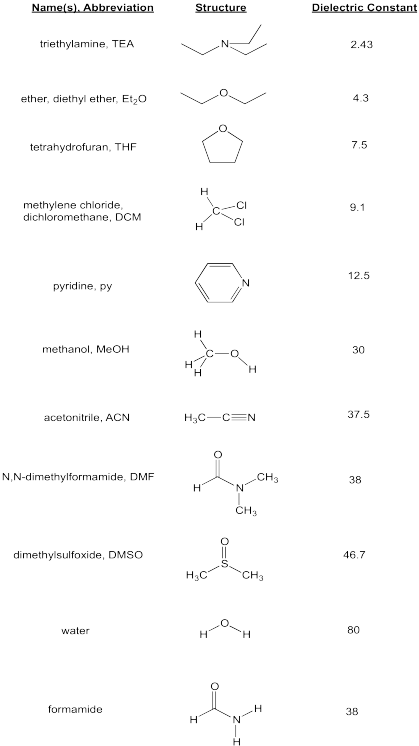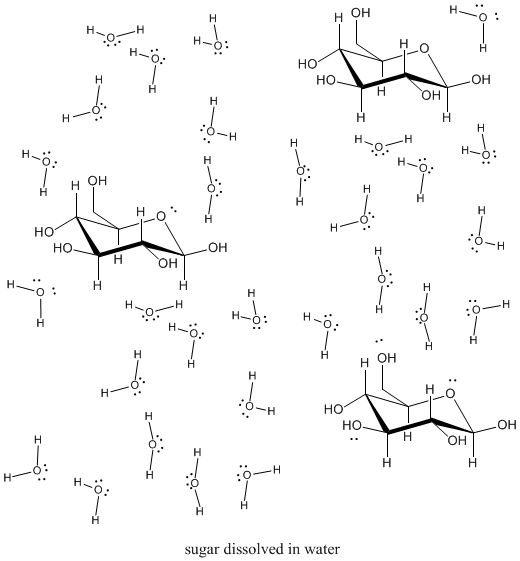
Structure & Reactivity in Chemistry
Structure-Property Relationships
SP10. Solubility and Ions
In order for two substances to be miscible, or in order for one substance to be soluble in another, the two kinds of molecules must interact with each other. Not only that, but there must be strong enough attraction of one type of molecule for the other so that they are willing to move away from their identical siblings. If the attractive forces between the unlike molecules are strong enough to overcome those forces between both sets of like molecules, dissolution results.
Table salt dissolves in water because the very polar water molecules attract both the positively charged sodium ions and the negatively charged chloride ions. This interaction is called an ion / dipole interaction.
In order to distribute the sodium cations and chloride ions throughout the solution, some of the water molecules may need to back away from each other to make room for the ions. Some of the strong hydrogen bonds may be lost, but the energy needed to overcome those interactions is compensated by the attraction between the dipole of the water and the sodium or chloride ions.
Other salts dissolve in water, too, but some of them dissolve more easily than others. You could easily dissolve about 360 g of table salt in a liter of water, but the solubility of calcium carbonate is only about 0.01 grams per liter. That's partly due to the fact that the ions in sodium chloride, Na+ and Cl-, have lower charges than the ions in calcium carbonate, Ca2+ and CO32-. The higher the charges on the ions, the stronger their electrostatic attraction for each other, and the harder it is for the water to pull them apart. It's a good thing, too; if the calcium carbonate in marble were to dissolve too easily, think of how many buildings and statues would dissolve in the rain.
Problem SP10.1.
Rank the following salts from most easily to least easily dissolved in water: MgSO4, LiCl, AlPO3
The factors that control the solubility of ions can be complex, though. For example, the charges on the ions also affect the strength of the interaction with the water molecules. Highly charged ions interact more strongly with each other, but they also interact more strongly with water molecules.
There are other solvents that can dissolve salts via ion / dipole interactions. Typically they would have strong dipoles. However, not many solvents have dipoles as strong as that of water.
Table SP10.1. Dielectric constants for some common solvents.

Problem SP10.2.
Which of the following solvents would be most capable of dissolving some LiCl? Rank from greatest solubility to least solubility.
triethylamine, dimethylsulfoxide, dichloromethane, acetonitrile, pyridine.
Of course, it isn't just salts that can dissolve in solvents. Other solids can, too, if they can interact with solvent molecules strongly enough. Sugar also dissolves pretty well in water. Why do you think that is so?

Figure SP10.1. A mixture of glucose and water molecules.
Sugars, of course, can hydrogen bond easily with water, so they are usually pretty water-soluble. In order to be separated from each other, the hydrogen bonds between water molecules must be overcome. The same is true for sugar molecules. That costs energy. However, water molecules can form hydrogen bonds with sugar molecules. That releases energy. In this case, enough energy is released that a fair amount of sugar can dissolve in the right amount of water.
This site was written by Chris P. Schaller, Ph.D., College of Saint Benedict / Saint John's University (retired) with other authors as noted on individual pages. It is freely available for educational use.
 Structure & Reactivity in Organic, Biological and Inorganic Chemistry
by Chris Schaller is licensed under a
Creative Commons Attribution-NonCommercial 3.0 Unported License.
Structure & Reactivity in Organic, Biological and Inorganic Chemistry
by Chris Schaller is licensed under a
Creative Commons Attribution-NonCommercial 3.0 Unported License.
Send corrections to cschaller@csbsju.edu
Navigation: